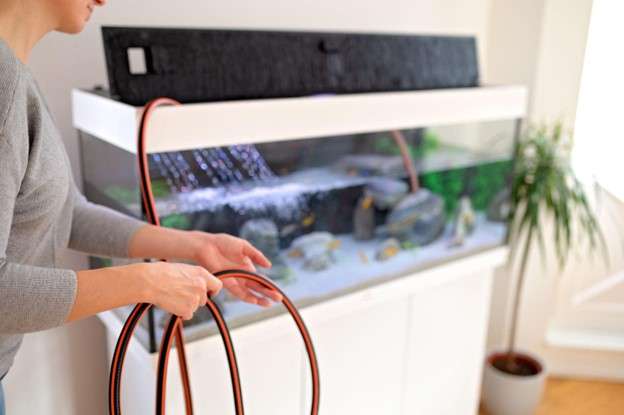For an aquarium to operate correctly, the water circulation must be good. Water movement affects the health of both plants and fish. It helps remove aquarium waste and keeps water from collecting in particular areas. The primary device for water circulation in your aquarium is a water pump. If you already have a water pump, you can tweak it to speed up water flow through your tank. Water pumps are long-lasting, cost-effective, and reliable. Additionally, installing them is easy.
Types of Aquarium Water Pumps
- Submersible Pumps
These are the most typical pumps found in virtually all aquariums. They don’t require a power supply because they are submerged in the water, which makes them perfect for tiny tanks. The sole drawback is that when dirt accumulates in their intake pipe, they can be challenging to clean. However, this is typically simple to remedy with a bit of perseverance and hard work.
- External/Inline Pumps
These pumps don’t require any power sources; they force water into the tank through their intake pipe! They rest on top of your aquarium, where you can easily access them without needing tools like pliers or wrenches, making them ideal for large aquariums because they don’t take up any space inside your aquarium. The only drawback is that if you want your tank to be as aerated as possible, you might need additional room around it.
- Powerheads
The simple function of powerheads, propellers that rotate within your tank’s water column, is to transfer water from one area to another. They’re an excellent choice for maintaining momentum when you need it. They assist in preserving everything at top performance in larger tanks by dispersing nutrients equally across all aquarium sections.
Benefits of Using a Water Pump in Aquariums
Using a water pump in your aquarium has several advantages.
– Oxygenation: Fish and other aquatic species benefit from increased oxygen exchange at the water’s surface due to water pumps.
– Filtration Efficiency: Fish and other aquatic species benefit from increased oxygen exchange at the water’s surface due to water pumps.
– Creation of Natural Water Currents: By generating currents that resemble the natural movement of nature, water pumps aid in simulating natural habitats for fish and aquatic plants.
– Prevention of Stagnant Zones: Water pumps prevent debris buildup and potential harmful zones in your aquarium by providing an outlet for excess waste products.
How to Choose the Right Aquarium Water Pump
1. Size & Capacity: The more gallons per hour your aquarium can hold, the bigger it is. However, only some pumps can manage a large aquarium. Depending on how much water flows through it and how strong it is.
2. Noise Level: A pump’s sound is essential to consider, especially for living environments. Let’s say you live with housemates or kids. In that case, you should carefully evaluate noise levels before selecting one that won’t bother others, result in sleep problems, or divert attention away from tasks like homework or sports practice!
3. Functionality: When choosing an aquarium pump, it’s crucial to distinguish between primary pumps and those with extra functions like wave-makers or timers. These additional features can drastically alter the convenience of usage and general quality of life for your fish!
There are several different aquarium layouts, each with a particular set of needs.
Freshwater Aquariums: A filter and a heater are necessary for freshwater aquariums. The filter ought to be able to meet the tank’s present requirements.
Saltwater Aquariums: A pump, salt water, and live rock are necessary for saltwater aquariums. The pump takes extra water out of the tank and circulates the water inside. To provide your fish and coral nourishment, live rock has been placed.
Reef Aquariums: Corals of all different sizes and shapes are needed for reef aquariums. To survive in their natural habitat, these corals must be kept in an aquarium area that receives a lot of light and flow from above.
Common Issues and Maintenance Tips for Aquarium Pumps
1. Cleaning Frequency & Methods
Most pumps should be cleaned once a month, though this can change based on the model and how frequently you use it. While larger pumps typically won’t need as often maintenance, smaller pumps that don’t need to move a lot of water should be cleaned more frequently.
2. Recognizing Signs of Malfunction
Your aquariums may experience issues if your pumps aren’t working correctly, so you should inspect them frequently. Check the water volume, flow, and any possible operating noises. Contact your neighborhood aquarium supply store or aquarium specialist immediately if you detect any unusual behavior so they can examine your pump and decide whether or not it needs to be replaced.
3. Ensuring Longevity
Regular cleaning is necessary to preserve the Longevity of pumps. They will only eventually succeed if you wash them frequently. It’s crucial to watch for wear on the impeller and other body components like shafts, bearings, and seals. They could eventually fail if not taken care of before they become too expensive or challenging to replace.
4. Troubleshooting Minor Issues
You may check if your pump isn’t performing as well as it once did or if you’re experiencing reduced flow or increased noise. Checking the filter should be done first. A filthy filter may interfere with the operation of the pump. Next, make sure your water is at the proper level. The water level must be correct for the pump to function correctly. Finally, consider getting a new pump if you have any of these problems and have already fixed them.
Conclusion
This article should have assisted you in selecting the ideal aquarium water pump and made maintaining your new tankless less frightening. Just as crucial as keeping your fish and plants healthy is maintaining the condition of your aquatic equipment. If something isn’t working properly, it doesn’t matter how beautiful it is, so routine maintenance should be a part of your routine for any equipment.

